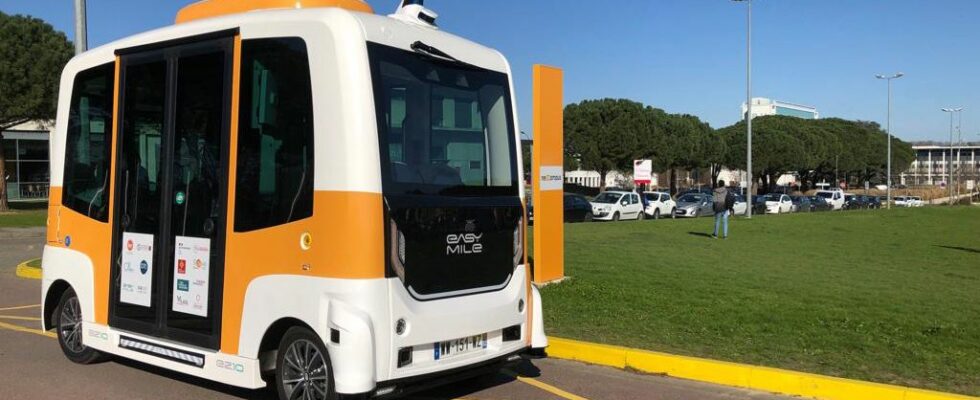Sudden but effective emergency braking. A student “experimenter” has just demonstrated his blind faith in science by crossing, laughing, right in front of the autonomous shuttle. A few tens of meters further, the test is this time involuntary: a motorist parked on the stop of the small “berlingot” mounted on wheels. The latter reacts perfectly, under the dumbfounded gaze of the intruder (who will always be parked in the same place one rotation later), he slams, swerves and takes off to park and honor his stop. “There hasn’t been the slightest incident or accident so far”, assures Philippe Perrollaz, the operator responsible, with his huge gray joystick, for taking over “manually” on the shuttle in the event of an emergency. .
Covered with lidars and sensors, the machine – with 12 seats, half of which are seated – is a model from the Toulouse manufacturer EasyMile. He landed discreetly last November on the campus of Toulouse III Paul Sabatier University in the program VILAGIL led by Toulouse Métropole, which supports the development of actions in favor of innovative and low-carbon mobility.
The electric shuttle is free. It theoretically makes five rotations per day, with four fixed stops, over the 4.5 kilometers of its route. “But sometimes it doesn’t pass because we’re working on it. It is not a public service, it is an experimentation laboratory, we have explained it well to users”, warns Professor Marie-Pierre Gleizes, of the Computer Science Research Institute of Toulouse (Irritates) and the university’s Faculty of Science and Engineering. She supervises the research actions of the VILAGIL program.
The first in a real situation in heavy traffic
In Toulouse, users have a little habit of autonomous shuttles. A demonstrator circulated on the Jules-Guesde alleys a few years ago. Another travels between the Oncopole building and its car park. “But ours allows us to really move on to experimentation in real situations in dense urban areas”, emphasizes Rahim Kacimi, lecturer at Irit. Very dense even, with its 36,000 “inhabitants”, its cars, its congestion, its students absorbed by the music in their helmets.
Thanks to them, the team will be able to explore several lines of research. “The first concerns the communication networks of this type of vehicle with the infrastructure, but also with other vehicles, and with pedestrians,” explains Rahim Kacimi. To do this, the specialists monitor the data from the shuttle in their data center. They also use an RTK antenna (for “real time kinetic”), made available to them by Toulouse Métropole, to follow the movements and behavior of the shuttle “to the nearest centimeter” when a GPS does not have this precision of resolution. Soon droids circulating on campus will be equipped to communicate with the shuttle. And then there is Philippe’s feedback. The operator, who embarked 13 curious students on Wednesday, sees them getting “delighted and without apprehension” in this driverless minibus. If he clings to his joystick, anticipating the impromptu stop, when a bicycle comes in front and threatens to shave his shuttle, he is quite blown away when she slows down alone to get in step behind the clusters of students at the moment of the attendance of the midday break in front of the RU.
Intelligent delivery droids and streetlights
In a few days, two weeks at most, the shuttle will save a lot of time on the twenty-three minutes of its current journey. The four “firefighter barriers” along his route will be connected and Philippe will no longer have to go down to “badge”. And since the shuttle is there “for at least two years”, the students have plenty of time to get used to it. They will even soon be put to use. Because another team of researchers is working at Jean-Jaurès University on “social acceptability” and the perception of autonomous vehicles.
Then, shortly, the shuttle will no longer be alone. Then, shortly, the shuttle will no longer be alone. The three TwinsWheel Company delivery droids will begin crossing its path, likely in May, at the same time as smart street lights (funded by the region) turn on. The Paul-Sabatier University campus will then become, with its autOCampus platform, a “unique in France” site for experimenting with the mobility of the future.

